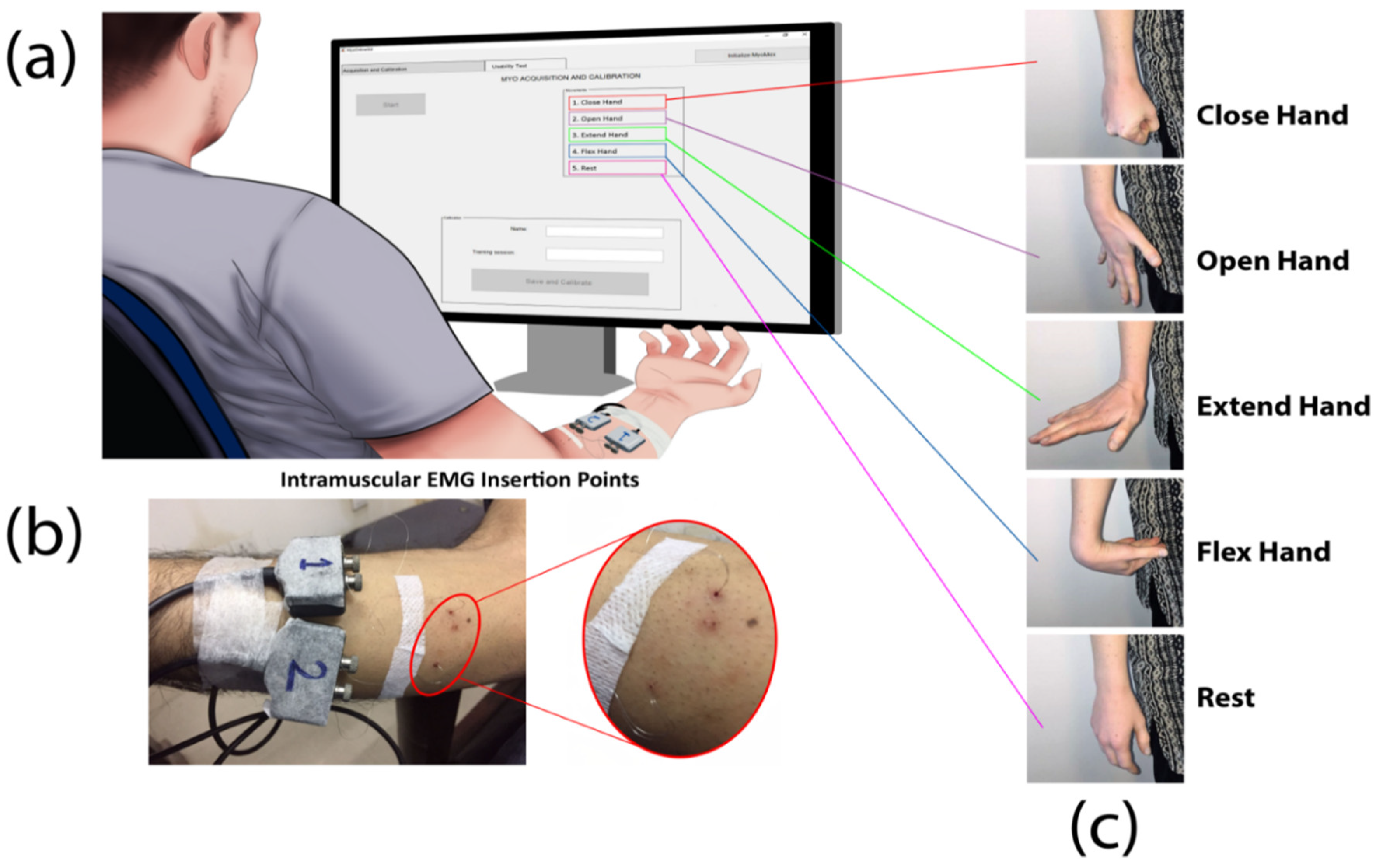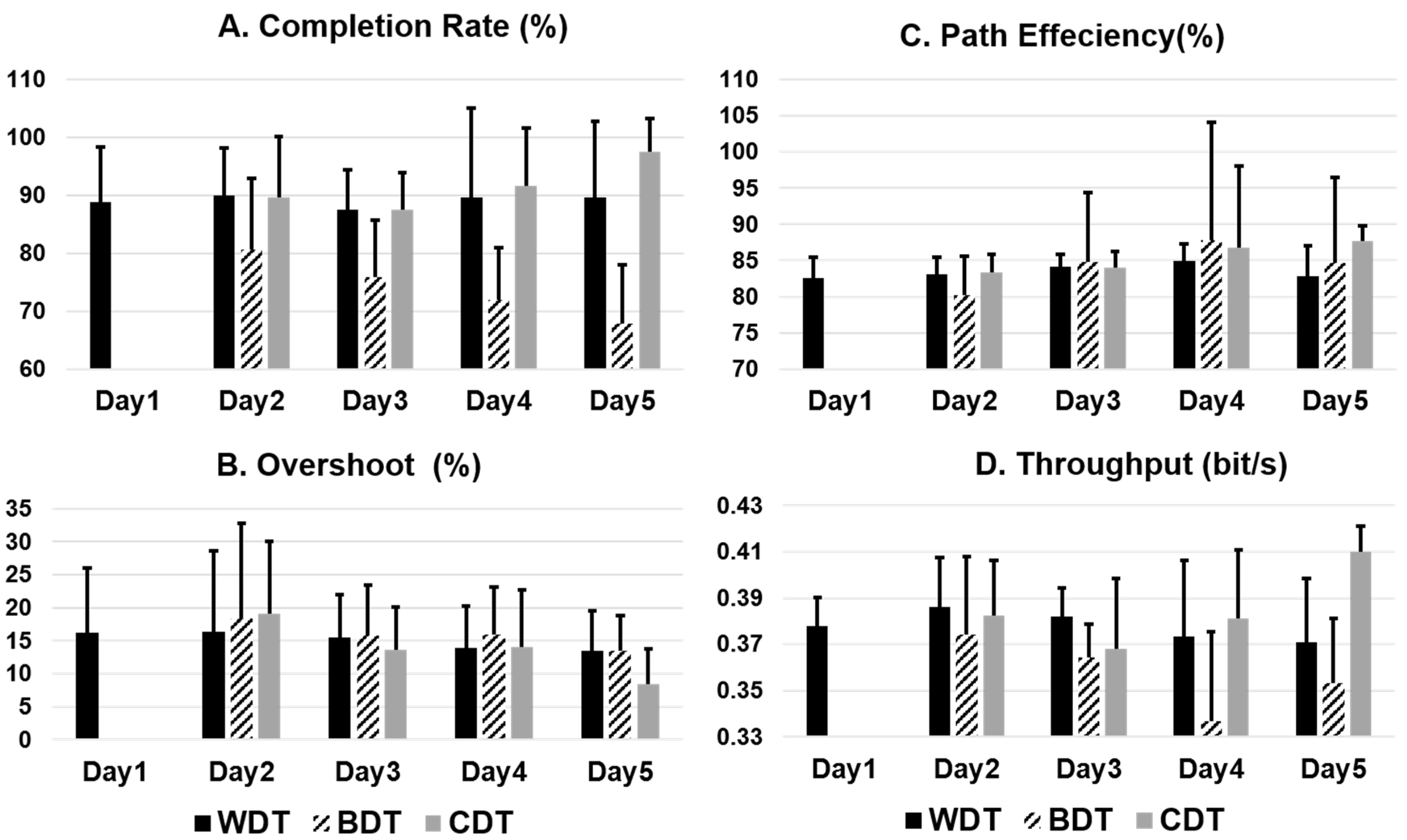A Multiday Evaluation of Real-Time Intramuscular EMG Usability with ANN
Abstract
:1. Introduction
2. Materials and Methods
2.1. Subjects
2.2. Experimental Procedures
2.3. Experimental Scheme
2.4. Feature Extraction and Experimental Procedure
2.5. Statistics
3. Results
3.1. Offline Data Analysis
3.2. Fitts’ Law Test (Online Results)
4. Discussion
5. Conclusions
Author Contributions
Funding
Conflicts of Interest
Ethical Approval
References
- Herberts, P.; Kadefors, R.; Kaiser, E.; Petersén, I. Implantation of micro-circuits for myo-electric control of prostheses. J. Bone Jt. Surg. Br. Vol. 1968, 50, 780–791. [Google Scholar] [CrossRef] [Green Version]
- Tucker, F.R.; Peteleski, N. Microelectronic telemetry implant for myo-electric control of a powered prosthesis. Can. Electr. Eng. J. 1977, 2, 3–8. [Google Scholar] [CrossRef]
- Stein, R.B.; Charles, D.; Hoffer, J.A.; Arsenault, J.; Davis, L.A.; Moorman, S.; Moss, B. New approaches for the control of powered prostheses particularly by high-level amputees. Bull. Prosthet. Res. 1980, 10, 51–62. [Google Scholar] [PubMed]
- De Luca, C.J.; LeFever, R.S.; McCue, M.P.; Xenakis, A.P. Control scheme governing concurrently active human motor units during voluntary contractions. J. Physiol. 1982, 329, 129–142. [Google Scholar] [CrossRef] [PubMed]
- Nawab, S.H.; Wotiz, R.P.; DeLuca, C.J. Decomposition of indwelling EMG signals. J. Appl. Physiol. 2008, 105, 700–710. [Google Scholar] [CrossRef] [PubMed] [Green Version]
- Marateb, H.R.; McGill, K.C. Resolving superimposed MUAPs using particle swarm optimization. IEEE Trans. Biomed. Eng. 2009, 56, 916–919. [Google Scholar] [CrossRef] [Green Version]
- Parsaei, H.; Stashuk, D.W. EMG signal decomposition using motor unit potential train validity. IEEE Trans. Neural Syst. Rehabil. Eng. 2013, 21, 265–274. [Google Scholar] [CrossRef] [Green Version]
- Gazzoni, M.; Farina, D.; Merletti, R. A new method for the extraction and classification of single motor unit action potentials from surface EMG signals. J. Neurosci. Methods 2004, 136, 165–177. [Google Scholar] [CrossRef]
- Holobar, A.; Zazula, D. Correlation-based decomposition of surface electromyograms at low contraction forces. Med Biol. Eng. Comput. 2004, 42, 487–495. [Google Scholar] [CrossRef]
- Weir, R.F.; Troyk, P.R.; DeMichele, G.A.; Kerns, D.A.; Schorsch, J.F.; Maas, H. Implantable myoelectric sensors (IMESs) for intramuscular electromyogram recording. IEEE Trans. Biomed. Eng. 2009, 56, 159–171. [Google Scholar] [CrossRef] [Green Version]
- Young, D.J. Wireless powering and data telemetry for biomedical implants. In Proceedings of the 2009 Annual International Conference of the IEEE Engineering in Medicine and Biology Society, Minneapolis, MN, USA, 3–6 September 2009; pp. 3221–3224. [Google Scholar]
- Bercich, R.A.; Joseph, J.; Gall, O.Z.; Maeng, J.; Kim, Y.J.; Irazoqui, P.P. Implantable device for intramuscular myoelectric signal recording. In Proceedings of the 34th Annual International Conference of the IEEE EMBS, San Diego, CA, USA, 28 August 2012. [Google Scholar]
- McDonnall, D.; Hiatt, S.; Smith, C.; Guillory, K.S. Implantable multichannel wireless electromyography for prosthesis control. In Proceedings of the 2012 Annual International Conference of the IEEE Engineering in Medicine and Biology Society, San Diego, CA, USA, 28 August 2012; pp. 1350–1353. [Google Scholar]
- Pasquina, P.F.; Evangelista, M.; Carvalho, A.J.; Lockhart, J.; Griffin, S.; Nanos, G.; McKay, P.; Hansen, M.; Ipsen, D.; Vandersea, J.; et al. First-in-man demonstration of a fully implanted myoelectric sensors system to control an advanced electromechanical prosthetic hand. J. Oneuroscience Methods 2015, 244, 85–93. [Google Scholar] [CrossRef] [PubMed] [Green Version]
- McDonnall, S.; Hiat, S.; Crofts, B.; Smith C and Merrill, D. Development of a wireless multichannel myoelectric implant for prosthesis control. In Proceedings of the Myoelectric Control and Upper Limb Prosthetics Symposium. (MEC 2017), Fredericton, NB, Canada, 15–18 August 2017; p. 21. [Google Scholar]
- Merrill, D.R.; Lockhart, J.; Troyk, P.R.; Weir, R.F.; Hankin, D.L. Development of an implantable myoelectric sensor for advanced prosthesis control. Artif. Organs 2011, 35, 249–252. [Google Scholar] [CrossRef] [PubMed]
- Jacobson, W.C.; Gabel, R.H.; Brand, R.A. Surface vs. fine-wire electrode ensemble-averaged signals during gait. J. Electromyogr. Kinesiol. 1995, 5, 37–44. [Google Scholar] [CrossRef]
- Smith, L.H.; Hargrove, L.J. Comparison of surface and intramuscular EMG pattern recognition for simultaneous wrist/hand motion classification. In Proceedings of the 2013 35th annual international conference of the IEEE engineering in medicine and biology society (EMBC), IEEE, Osaka, Japan, 3–7 July 2013; pp. 4223–4226. [Google Scholar]
- Kamavuako, E.N.; Scheme, E.J.; Englehart, K.B. Combined surface and intramuscular EMG for improved real-time myoelectric control performance. Biomed. Signal Process. Control 2014, 10, 102–107. [Google Scholar] [CrossRef]
- Kamavuako, E.N.; Scheme, E.J.; Englehart, K.B. On the usability of intramuscular EMG for prosthetic control: A Fitts’ law approach. J. Electromyogr. Kinesiol. 2014, 24, 770–777. [Google Scholar] [CrossRef]
- Hargrove, L.J.; Englehart, K.; Hudgins, B. A comparison of surface and intramuscular myoelectric signal classification. IEEE Trans. Biomed. Eng. 2007, 54, 847–853. [Google Scholar] [CrossRef]
- Waris, A.; Niazi, I.K.; Jamil, M.; Gilani, O.; Englehart, K.; Jensen, W.; Shafique, M.; Kamavuako, E.N. The effect of time on EMG classification of hand motions in able-bodied and transradial amputees. J. Electromyogr. Kinesiol. 2018, 40, 72–80. [Google Scholar] [CrossRef] [Green Version]
- He, J.; Zhang, D.; Jiang, N.; Sheng, X.; Farina, D.; Zhu, X. User adaptation in long-term, open-loop myoelectric training: Implications for EMG pattern recognition in prosthesis control. J. Neural Eng. 2015, 12, 046005. [Google Scholar] [CrossRef]
- Jain, S.; Singhal, G.; Smith, R.J.; Kaliki, R.; Thakor, N. Improving long term myoelectric decoding, using an adaptive classifier with label correction. In Proceedings of the2012 4th IEEE RAS & EMBS International Conference on Biomedical Robotics and Biomechatronics (BioRob), IEEE, Rome, Italy, 24–27 June 2012; pp. 532–537. [Google Scholar]
- Waris, A.; Kamavuako, E.N. Effect of threshold values on the combination of emg time domain features: Surface versus intramuscular emg. Biomed. Signal Process. Control 2018, 45, 267–273. [Google Scholar] [CrossRef] [Green Version]
- Waris, A.; Mendez, I.; Englehart, K.; Jensen, W.; Kamavuako, E.N. On the robustness of real-time myoelectric control investigations: A multiday Fitts’ law approach. J. Neural Eng. 2019, 16, 026003. [Google Scholar] [CrossRef] [Green Version]
- Fitts, P.M.; Radford, B.K. Information capacity of discrete motor responses under different cognitive sets. J. Exp. Psychol. 1966, 71, 475. [Google Scholar] [CrossRef] [PubMed]
- Gusman, J.; Mastinu, E.; Ortiz-Catalán, M. Evaluation of Computer-Based Target Achievement Tests for Myoelectric Control. IEEE J. Transl. Eng. Health Med. 2017, 5, 1–10. [Google Scholar] [CrossRef] [PubMed]
- Wurth, S.M.; Hargrove, L.J. A real-time comparison between direct control, sequential pattern recognition control and simultaneous pattern recognition control using a Fitts’ law style assessment procedure. J. Neuroeng. Rehabil. 2014, 11, 91. [Google Scholar] [CrossRef] [PubMed] [Green Version]
- Williams, M.R.; Kirsch, R.F. Evaluation of head orientation and neck muscle EMG signals as command inputs to a human–computer interface for individuals with high tetraplegia. IEEE Trans. Neural Syst. Rehabil. Eng. 2008, 16, 485–496. [Google Scholar] [CrossRef] [PubMed] [Green Version]
- Waris, A.; Niazi, I.K.; Jamil, M.; Englehart, K.; Jensen, W.; Kamavuako, E.N. Multiday evaluation of techniques for EMG based classification of hand motions. IEEE J. Biomed. Health Inform. 2018, 23, 1526–1534. [Google Scholar] [CrossRef]
- Zia ur Rehman, M.; Waris, A.; Gilani, S.; Jochumsen, M.; Niazi, I.; Jamil, M.; Farina, D.; Kamavuako, E. Multiday EMG-based classification of hand motions with deep learning techniques. Sensors 2018, 18, 2497. [Google Scholar] [CrossRef] [Green Version]






| Day 1 | Day 2 | Day 3 | Day 4 | Day 5 | |
|---|---|---|---|---|---|
| WDT | Train1 Test1 | Train2 Test2 | Train3 Test3 | Train4 Test4 | Train5 Test5 |
| BDT | Train1 Test2 | Train2 Test3 | Train3 Test4 | Train4 Test5 | |
| CDT | Train1–2 Test2 | Train1–2–3 Test3 | Train1–2–3–4 Test4 | Train1–2–3–4–5 Test5 |
| Feature | Description | Formula |
|---|---|---|
| MAV | Mean Absolute Value (MAV) is the average of the absolute value of the EMG signal. It is an indication of muscle contraction levels. | |
| WL | Waveform length (WL) is related to the fluctuations of a signal when the muscle is active. Thus, the feature provides combined information about the frequency, duration and waveform amplitude of the EMG signal. | |
| ZC | Zero Crossing (ZC) measures the number of crosses by zero of the signal and is related to the frequency content of the signal. This feature provides an approximate estimation of frequency domain properties. | |
| SSC | Slope Sign Changes (SSC) measures the number of times the sign changes in the slope of the signal. It is another method to represent the frequency information of the sEMG signal. | |
| WAMP | Willison Amplitude (WAMP) estimates the number of active motor units, which is an indicator of the level of muscle contraction. | |
| CARD | Cardinality of a set is a measure of the number of distinct values. This can be computed in two steps. Data needs to be sorted and one sample is distinct from the next if the difference is above a predefined threshold. |
| Distance (D) | Width (W) | Index of Difficulty (ID) |
|---|---|---|
| 50 | 5 | 3.46 |
| 50 | 10 | 2.59 |
| 50 | 20 | 1.81 |
| 100 | 5 | 4.39 |
| 100 | 10 | 3.46 |
| 100 | 20 | 2.59 |
| BDT | WDT | CDT | |
|---|---|---|---|
| 1.81 | 5.47 ± 1.45 | 5.31 ± 0.80 | 4.88 ± 0.56 |
| 2.58 | 8.45 ± 2.61 | 8.21 ± 2.74 | 8.04 ± 2.44 |
| 3.46 | 8.67 ± 2.78 | 8.63 ± 2.56 | 8.48 ± 2.48 |
| 4.39 | 11.71 ± 1.34 | 11.27 ± 0.87 | 10.97 ± 1.33 |
| Within-Day Testing (WDT) | |||
|---|---|---|---|
| Session 1 | Session 2 | Session 3 | |
| Completion Rate | 90.3 ± 10.5 | 88.5 ± 10.2 | 88.7 ± 1.1 |
| Overshoot | 15.6 ± 8.5 | 14.5 ± 8.6 | 15.2 ± 9.1 |
| Path Efficiency | 83.4 ± 3.2 | 84.4 ± 3.3 | 82.7 ± 3.6 |
| Throughput | 38.1 ± 1.8 | 37.7 ± 2.6 | 37.6 ± 2.4 |
| Between-Day Testing (BDT) | |||
| Session1 | Session 2 | Session 3 | |
| Completion Rate | 77.9 ± 14.0 (*) | 72.3 ± 15.9 | 71.9 ± 17.6 |
| Overshoot | 33.2 ± 10.8 | 33.5 ± 11.2 | 28.5 ± 5.8 |
| Path Efficiency | 88.9 ± 16.9 (*) | 83.1 ± 9.1 | 81.1 ± 7.9 |
| Throughput | 35.8 ± 3.2 | 36.1 ± 3.2 | 35.1 ± 3.5 |
| Combined-Day Testing (CDT) | |||
| Session 1 | Session 2 | Session 3 | |
| Completion Rate | 94.0 ± 6.7 | 91.5 ± 9.5 | 89.4 ± 10.3 |
| Overshoot | 14.1 ± 11.0 | 13.0 ± 10.7 | 14.3 ± 11.6 |
| Path Efficiency | 85.6 ± 3.1 | 86.7 ± 3.6 | 84.1 ± 3.1 |
| Throughput | 39.2 ± 2.4 | 38.5 ± 2.9 | 38.0 ± 3.3 |
© 2020 by the authors. Licensee MDPI, Basel, Switzerland. This article is an open access article distributed under the terms and conditions of the Creative Commons Attribution (CC BY) license (http://creativecommons.org/licenses/by/4.0/).
Share and Cite
Waris, A.; Zia ur Rehman, M.; Niazi, I.K.; Jochumsen, M.; Englehart, K.; Jensen, W.; Haavik, H.; Kamavuako, E.N. A Multiday Evaluation of Real-Time Intramuscular EMG Usability with ANN. Sensors 2020, 20, 3385. https://doi.org/10.3390/s20123385
Waris A, Zia ur Rehman M, Niazi IK, Jochumsen M, Englehart K, Jensen W, Haavik H, Kamavuako EN. A Multiday Evaluation of Real-Time Intramuscular EMG Usability with ANN. Sensors. 2020; 20(12):3385. https://doi.org/10.3390/s20123385
Chicago/Turabian StyleWaris, Asim, Muhammad Zia ur Rehman, Imran Khan Niazi, Mads Jochumsen, Kevin Englehart, Winnie Jensen, Heidi Haavik, and Ernest Nlandu Kamavuako. 2020. "A Multiday Evaluation of Real-Time Intramuscular EMG Usability with ANN" Sensors 20, no. 12: 3385. https://doi.org/10.3390/s20123385
APA StyleWaris, A., Zia ur Rehman, M., Niazi, I. K., Jochumsen, M., Englehart, K., Jensen, W., Haavik, H., & Kamavuako, E. N. (2020). A Multiday Evaluation of Real-Time Intramuscular EMG Usability with ANN. Sensors, 20(12), 3385. https://doi.org/10.3390/s20123385








